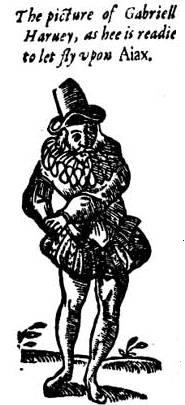Gabriel Harvey facts for kids
Gabriel Harvey (born around 1552 or 1553, died 1631) was an English writer and scholar. He was known for his smart ideas, but also for his big arguments with another writer named Thomas Nashe. Some people say his Latin writings show he was much more than just a proud or overly academic person.
Contents
Gabriel's Family
Gabriel Harvey was the oldest son of John Harvey (who died in 1593). John was a farmer and a skilled rope maker from Saffron Walden, Essex. Gabriel's mother was Alice (who died in 1613). He had two younger brothers, Richard and John, and a sister named Mercy.
His Education
Gabriel Harvey went to the grammar school in his hometown. In 1566, he started studying at Christ's College, Cambridge. By 1570, he became a fellow (a kind of teacher or researcher) at Pembroke Hall. Here, he became good friends with the famous poet Edmund Spenser, who might have even been his student.
Trying New Poetry Styles
Gabriel Harvey really wanted to be remembered as the "inventor of the English Hexameter". This was a special type of poetry that followed strict rules from Latin. He was a key member of a group called the Areopagus. This group tried to make English poems follow the same rhythm rules as Latin poems.
In a letter to Edmund Spenser, Harvey said that Edward Dyer and Philip Sidney were helping with their "new famous enterprise." This project aimed to change "barbarous" (meaning rough or unpolished) English rhymes into "artificial" (meaning carefully crafted) verses.
Harvey even gave examples of these new English hexameters. But another writer, Thomas Nashe, found Harvey's poetry style quite funny. Nashe joked that Harvey "goes twitching and hopping in our language." He also made fun of Harvey in a poem:
"But ah ! what news do you hear of that good Gabriel Huff-Snuff,
Known to the world for a fool, and clapped in the Fleet for a rhymer?"
Even though Harvey's poetry experiments were mocked, he greatly influenced Spenser for a short time. Their friendship lasted, and Harvey is even featured in Spenser's poem The Shepheardes Calender as the character "Hobbinoll." This shows the good side of Harvey's personality, even though he often seemed stubborn and argumentative to others.
Gabriel's Career
Around 1576, Gabriel Harvey became a teacher of rhetoric (the art of speaking or writing effectively). In 1578, when Queen Elizabeth I visited Sir Thomas Smith at Audley End House, Harvey was chosen to debate publicly in front of the Queen.
In 1583, he became a junior proctor at Cambridge University. In 1585, he was elected master of Trinity Hall, where he had been a fellow since 1578. However, this appointment was stopped by the court. Harvey was supported by Robert Dudley, Earl of Leicester, who also introduced him to Philip Sidney. Despite this support, his second attempt to become master of Trinity Hall failed in 1598.
In 1585, he earned a law degree from the University of Oxford and started working as a lawyer in London.
His Feud with Other Writers
Gabriel's brother, Richard Harvey, had upset a writer named Robert Greene. Greene then wrote a book called A Quip for an Upstart Courtier. In it, he made fun of all four Harvey brothers, pointing out that their father was a rope maker.
In 1599, Archbishop Whitgift ordered many satirical books to be destroyed. This included the writings of both Harvey and Nashe. It was also forbidden to print them again. Gabriel Harvey spent his last years living quietly in Saffron Walden, where he died on February 7, 1631.
A book called The Letter-Book of Gabriel Harvey, AD, 1573–80 (published in 1884) contains his letters. These include drafts of his letters with Spenser and notes about arguments at Pembroke Hall.
A Creator of Words
Gabriel Harvey was also a "wordsmith," meaning he was good with words. He is believed to have created or been the first to use several English words. For example, he used the word "jovial" (meaning cheerful) around 1590. He is also credited with words like "conscious," "extensively," "idiom," "notoriety," and "rascality."
His rival, Thomas Nashe, even criticized Harvey for making up new words. Nashe said he disliked Harvey's words and predicted they would not last. However, many of them did! A book called The Facts on File Encyclopedia of Word and Phrase Origins also credits Harvey with creating these words.
His Big Fight with Thomas Nashe
After Robert Greene died, Harvey wrote a book called Foure Letters and certaine Sonnets (1592). In this book, he shared sad details about Greene's final years. Thomas Nashe then got his revenge on the Harveys in his book Strange Newes (1593).
Harvey replied to Nashe's attacks in his own book, Pierce's supererogation, or a New Prayse of the Old Asse (1593). Later, in a religious book called Christs Teares over Jerusalem (1593), Nashe actually apologized to Harvey. However, Harvey continued the argument in a New Letter of Notable Contents (1593). It seems Harvey had not yet seen Nashe's apology in print when he wrote his new letter. He wanted clear proof of Nashe's change of heart.
Nashe later took back his apology in a new edition of Christes Teares (1595). He claimed that Harvey had tricked him into making a public apology, only to make him look foolish. Nashe wrote:
- "Impious Gabriel Harvey... hath with a cunning ambuscado... welnear betrayed me to infamy eternal."
He added that "the devil and he be no men of their words."
It took almost two years for Nashe to reply to Harvey's New Letter. When he heard that Harvey was boasting about winning the argument, Nashe wrote his most biting satire, Have with You to Saffron-Walden (1596). Harvey never responded to this book. Later, another writer named Richard Lichfield attacked Nashe in The Trimming of Thomas Nashe Gentleman (1597). This work was once thought to be written by Harvey himself.


